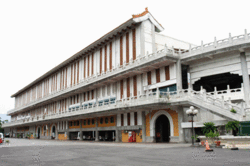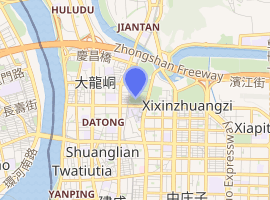Zhongshan Soccer Stadium
Zhongshan Soccer Stadium, Chungshan Soccer Stadium, or Taipei Soccer Stadium (Chinese: 中山足球場; pinyin: Zhōngshān Zúqíuchǎng) was a multi-purpose stadium in Zhongshan District, Taipei, Taiwan. It was established in 1923 as Maruyama Stadium (Japanese: 圓山運動場) during the Japanese period. The soccer stadium was opened in 1989, it was reconstructed from the former site of Yuanshan Baseball Ground (Chinese: 圓山棒球場) under the guidance of then Chinese Taipei Football Association President Chiang Wei-kuo.[1] Although it was built as a soccer-specific stadium, it was mostly used for live concerts or other activities due to lack of professional football league in Taiwan. The stadium was able to hold 20,000 people for football games and 40,000 for concerts. It was managed by the Hope Foundation led by former athlete Chi Cheng.
 | |

| |
| Location | Taipei, Taiwan |
|---|---|
| Coordinates | 25°4′10.2″N 121°31′15.8″E |
| Owner | Taipei Sports Office |
| Operator | Taipei Sports Office |
| Capacity | 20,000 (Football) 40,000 (Concerts) |
| Field size | 300 x 184 m |
| Surface | Grass |
| Opened | 1989 |
| Closed | 2008 |
| Zhongshan Soccer Stadium | |||||||||||||||
|---|---|---|---|---|---|---|---|---|---|---|---|---|---|---|---|
| Traditional Chinese | 中山足球場 | ||||||||||||||
| Simplified Chinese | 中山足球场 | ||||||||||||||
| |||||||||||||||
Location
Zhongshan Soccer Stadium was located across of Yumen Street (Chinese: 玉門街) and Minzu West Road (Chinese: 民族西路). Nearby was the Yuanshan Station of Taipei Metro (Tamsui Line, Red Line)
Events
The stadium has hosted a number of concerts by internationally renowned music stars. The King of Pop Michael Jackson performed two sold out concerts at the stadium on October 18 and 22 1996, during his History World Tour (attendance : 98.000). Bon Jovi performed at the stadium on April 28, 1995 during These Days Tour. Australian pop star Kylie Minogue performed there on December 4, 2008 as part of her KylieX2008 world tour.
Closure
In March 2007, Taipei City Government announced that Yuanshan will be replacing Guandu Plain as the main venue of the 2010 International Garden and Horticulture Exhibition to be hosted in Taipei.[2] In their plan, Chungshan Soccer Stadium, being one of the major parts of the Yuanshan area, would serve as the primary venue of the exhibition featuring indoor activities. As a result, the stadium was closed on July 1, 2008.
However, the Chinese Taipei Football Association made a statement in its official site on June 29, 2007 opposing the proposal.[3] They stated that Chungshan Soccer Stadium was the only FIFA-approved stadium in Taiwan at present. If it is closed, Taiwan (Chinese Taipei) would lose its home ground and would not be allowed to hold international football competitions.
Though there were several ongoing construction projects for new stadiums, including the World Games Stadium for World Games 2009 in Kaohsiung and the new Taipei Municipal Stadium for 2009 Summer Deaflympics in Taipei. But both cannot be complete prior to the end of 2008.
On September 30, 2007, Taipei City Mayor Hau Lung-pin committed to delay the stadium's closing schedule to the end of 2008 for hosting 2010 FIFA World Cup qualification and 2008 AFC Challenge Cup qualifiers.[4] The stadium was closed on November 28, 2008.[5]
Transportation
The stadium was accessible within walking distance South East from Yuanshan Station of the Taipei Metro.
Gallery
 Chinese Taipei played home against South Korea in 2007 AFC Asian Cup qualification.
Chinese Taipei played home against South Korea in 2007 AFC Asian Cup qualification. Zhongshan Soccer Stadium
Zhongshan Soccer Stadium
References
- 從圓山棒球場到中山足球場 (in Chinese). Retrieved November 17, 2008.
- "City Selects Yuanshan as Main Venue for 2010 Horticulture Expo". Taipei City Government. 2007-03-16.
- "你們說可以嗎? (Do you say yes?)" (in Chinese). Chinese Taipei Football Association. 2007-06-29. Archived from the original on September 27, 2007.
- 花博會與足球賽衝場 中山足球場 明年底才封館 (in Chinese). China Times. 2007-09-30. Archived from the original on October 16, 2007.
- 【足球動態】封館3年多 足球場拿來展花 (in Chinese). Chinese Taipei Football Association. November 8, 2008. Archived from the original on April 15, 2009.
External links
| Wikimedia Commons has media related to Zhongshan Soccer Stadium. |